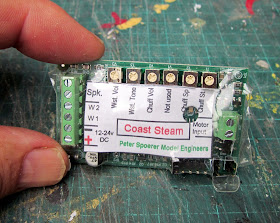The latest version of the MyLocoSound card was bought from Peter Spoerer. This version incorporates 'coasting' which senses when the loco is accelerating and decelerating and adjusts the volume of the chuff accordingly.
A wire was soldered to pad 6 of the Deltang rx61-22 receiver/controller. This pad is controlled by the bind button on the Tx22 transmitter and will be used to operate the sound card's whistle.
Because the sound card needs the input for the whistle to be connected to ground (-ve) to trigger the sound and the output from the receiver/controller is 3v (+ve), I constructed a simple transistor switch using the guidance provided on the Deltang website (see How I constructed a simple transistor switch)
A small 'laptop' speaker (provided by Peter Spoerer) was fixed to the cab roof with a double-sided sticky pad and the wires fed through into the firebox.
The internal bracing between the firebox and the boiler was pared down to accommodate the sound card (the blue/purple wires connect to the speaker and the red/black wires are the switched feed from the battery).
The wires were then connected to the terminal block on the sound card. From top to bottom:
Into the terminal block at the other end of the card went the leads to the motor and the leads from the controller/receiver for the motor and finally the two jumpers were removed from the sound card (for 'other' PWM controller settings).
This wiring diagram should hopefully make the setting-up a little more understandable (click to enlarge):
The chassis was then mounted on to a rolling road and the loco turned on so the sound board could be callibrated using the adjuster pots along the top of the board. From left to right:
Something I discovered is (of course) that the start setting and the upper speed differs when the loco is under load and so eventually I decided to find the happy medium between unloaded and loaded settings. The receiver/controller, switch and board were then slotted into the space for them between the firebox and the boiler ........
...... and the loco was taken outside for extensive test-running.
A wire was soldered to pad 6 of the Deltang rx61-22 receiver/controller. This pad is controlled by the bind button on the Tx22 transmitter and will be used to operate the sound card's whistle.
Because the sound card needs the input for the whistle to be connected to ground (-ve) to trigger the sound and the output from the receiver/controller is 3v (+ve), I constructed a simple transistor switch using the guidance provided on the Deltang website (see How I constructed a simple transistor switch)
A small 'laptop' speaker (provided by Peter Spoerer) was fixed to the cab roof with a double-sided sticky pad and the wires fed through into the firebox.
The internal bracing between the firebox and the boiler was pared down to accommodate the sound card (the blue/purple wires connect to the speaker and the red/black wires are the switched feed from the battery).
The wires were then connected to the terminal block on the sound card. From top to bottom:
- speaker wires (x2)
- spare
- whistle trigger (from the transistor switch)
- negative supply (and -ve lead to controller/receiver and to transistor switch)
- positive supply (and +ve lead to the controller/receiver)
Into the terminal block at the other end of the card went the leads to the motor and the leads from the controller/receiver for the motor and finally the two jumpers were removed from the sound card (for 'other' PWM controller settings).
This wiring diagram should hopefully make the setting-up a little more understandable (click to enlarge):
The chassis was then mounted on to a rolling road and the loco turned on so the sound board could be callibrated using the adjuster pots along the top of the board. From left to right:
- Whistle volume
- Whistle tone (from tiny peep to throaty roar)
- Chuff volume
- Spare
- Chuff speed (set to match the wheel speed at max)
- Chuff start (set to start the chuff when the wheels begin to move)
Something I discovered is (of course) that the start setting and the upper speed differs when the loco is under load and so eventually I decided to find the happy medium between unloaded and loaded settings. The receiver/controller, switch and board were then slotted into the space for them between the firebox and the boiler ........




















